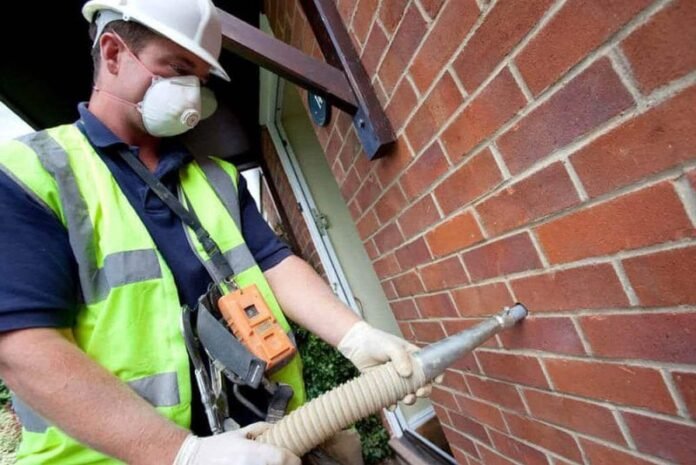Last Updated on July 14, 2024 by Asfa Rasheed
Cavity wall insulation is a cornerstone of energy-efficient building design, offering numerous benefits for thermal comfort, energy savings, and environmental sustainability. Understanding the importance of cavity wall insulation and the various options available can help architects, builders, and homeowners make informed decisions to maximize building performance. In this article, we’ll delve deeper into cavity wall insulation, its benefits, and the considerations for selecting the right insulation materials.
The Role of Cavity Wall Insulation:
Cavity wall insulation refers to the installation of insulating materials within the gap or cavity between the inner and outer walls of a building. The primary purpose of cavity wall insulation is to reduce heat loss or gain through the building envelope, thereby improving energy efficiency and thermal comfort. By creating a barrier to heat transfer, cavity wall insulation helps maintain stable indoor temperatures, reduces the need for mechanical heating and cooling systems, and lowers energy consumption and utility costs.
Benefits of Cavity Wall Insulation:
Improved Energy Efficiency: Cavity wall insulation helps minimize heat loss during colder months and heat gain during warmer months, resulting in reduced energy consumption for heating and cooling. This translates to lower utility bills and reduced environmental impact associated with energy use.
Enhanced Thermal Comfort: By providing a thermal barrier, cavity wall insulation helps maintain more consistent indoor temperatures, reducing drafts, cold spots, and overheating. This creates a more comfortable living or working environment for occupants year-round.
Condensation Control: Properly installed cavity wall insulation helps prevent condensation buildup within the building envelope by maintaining consistent indoor temperatures. This reduces the risk of moisture-related issues such as mold growth, dampness, and damage to building materials.
Noise Reduction: In addition to thermal insulation, cavity wall insulation can also provide acoustic insulation, helping to reduce the transmission of sound between interior and exterior spaces. This improves occupant comfort by minimizing noise from outside sources.
Long-Term Durability: Cavity wall insulation can contribute to the long-term durability and structural integrity of buildings by protecting against moisture infiltration, thermal cycling, and temperature extremes. This helps extend the lifespan of building materials and reduces the need for costly repairs and maintenance.
Considerations for Selecting Insulation Materials:
When selecting insulation materials for cavity walls, several factors should be considered:
Thermal Performance: Choose insulation materials with high thermal resistance (R-value) to maximize energy efficiency and thermal comfort. Consider factors such as the climate, building orientation, and desired level of insulation to determine the appropriate R-value for the project.
Moisture Resistance: Select insulation materials that are resistant to moisture and water vapor infiltration to prevent mold growth, rot, and degradation of building materials. Look for materials with a vapor barrier or moisture-resistant properties to ensure long-term durability.
Fire Safety: Prioritize insulation materials that have been tested and certified for fire safety to meet building code requirements and ensure occupant safety. Consider factors such as flame spread ratings, smoke development ratings, and fire retardant additives when evaluating insulation options.
Environmental Impact: Choose insulation materials with low embodied energy, minimal environmental impact, and sustainable manufacturing practices to reduce the carbon footprint of the building. Look for materials made from recycled or renewable resources and consider their recyclability or biodegradability at the end of their lifespan.
Installation Considerations: Consider the ease of installation and compatibility with existing building components when selecting insulation materials. Choose materials that are lightweight, easy to handle, and suitable for the specific cavity wall construction method used in the project.
Common Types of Cavity Wall Insulation Materials:
Mineral Wool: Mineral wool insulation, such as glass wool or rock wool, is a popular choice for cavity wall insulation due to its excellent thermal performance, fire resistance, and moisture resistance properties.
Foam Board: Rigid foam insulation boards, such as expanded polystyrene (EPS) or extruded polystyrene (XPS), are lightweight, moisture-resistant, and provide high thermal resistance.
Blown-In Insulation: Loose-fill insulation materials, such as cellulose or fiberglass, can be blown into the cavity using specialized equipment, providing seamless insulation coverage and excellent thermal performance.
Spray Foam: Spray foam insulation, such as polyurethane foam, can be applied as a liquid that expands to fill gaps and cracks within the cavity, providing a continuous insulation barrier with superior thermal resistance.
Conclusion:
Cavity wall insulation plays a vital role in enhancing building performance, energy efficiency, and occupant comfort. By selecting the right insulation materials and ensuring proper installation, architects, builders, and homeowners can create more sustainable, comfortable, and resilient buildings that meet the needs of occupants while minimizing environmental impact. With the myriad benefits of cavity wall insulation, it remains a key consideration in modern building design and construction practices. Contact One Insulation for more information.



























